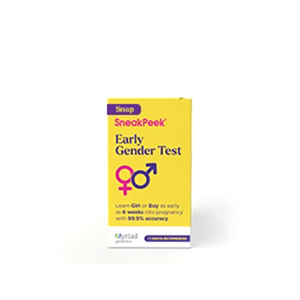Published on November 10th, 2021 and Updated on January 12th, 2024
Check out SneakPeek Gender Test to find out your baby’s gender as early as 6 weeks at over 99% accuracy1!
He’s squirming, he’s crying. And his teeny tummy? Swollen to the max. Your little one is gassy, and that can mean fussy days and sleepless nights—for both of you.
Infant gas troubles are normal and common, especially for newborns with developing digestive systems. But if your little one loses sleep over gas pains, you might be wondering if there are special sleep positions that might calm, or prevent, a troubled tummy.
So, what’s the best sleeping position for a gassy baby? According to the American Academy of Pediatrics (AAP), all babies (including gassy ones) should be placed to sleep on their backs until they turn one year old, as this is the safest sleeping position.
That said, there are steps you can take to get ahead of your baby’s gas troubles, so he’ll sleep soundly through the night, as well as some strategies you can try to prevent gas in the first place. Find out more below.
What does it mean if my baby is gassy?
Put simply, a gassy baby is a normal baby.
Newborns and infants under 6 months old have immature, developing digestive tracts. This means food may not always break down properly, resulting in gas, air that’s trapped in the stomach and/or intestines. Babies have tiny tummies that easily can become overfull with excess air, resulting in pain and pressure.
The good news? The discomfort is usually temporary. Like gas, it passes.
Signs You Have a Gassy Baby
So how do you know if it’s gas trouble that’s causing your little one’s distress? You’ll know that your baby is experiencing gas if she, well, lets it out—either as burps or flatulence.
She might also be suffering from gas-related discomfort if she:
- Becomes red in the face while crying
- Wriggles and pulls her legs up to her chest
- Acts increasingly fussy after feeding
- Has trouble eating or sleeping
Why Your Baby Might Be Gassy: Causes
Most of your little man’s gas pains will stem from his still-growing stomach and immature intestines. But if his gas trouble seems worse than usual, some other culprits may be to blame, including:
- Swallowing while sipping – Your baby likely takes to the breast or bottle with enthusiasm. The downside of that? He might be taking in some extra air with those big gulps, and extra air means excessive gas.
If you breastfeed, look for signs that he’s latching on properly to your breast and creating a seal on your nipple (you shouldn’t see your areola or his tongue).
For bottle-fed babies check the bottle’s nipple to ensure the hole is not too big (which encourages rapid drinking and excess air swallowing).
- Swallowing while crying – Crying that leads to more crying? The sobbing-to-gas pipeline is one teary, circular affair. Here’s why: when babies swallow air while crying for an extended amount of time, it can become trapped in their stomach and intestines, resulting in gas, which sets off a new round of sobs.
- Dietary sensitivities – Your little one may develop stomach distress not because he’s swallowing air, but because he has a food allergy or is sensitive to ingredients in his formula (or, if you’re breastfeeding, to the things that you’re consuming).
If you can’t pin down other causes for your baby’s discomfort, it might be worthwhile to look at your diet and consider limiting potentially aggravating ingredients, such as:
-
- Coffee
- Caffeinated sodas
- Dairy
- Chocolate
- Alcohol
- “Back is best” sleep position – Parenthood is magical, yes. But it can also be a little bit maddening, especially when the thing that you’re told you must do is also the very thing that’s causing your baby discomfort. This is the case with back sleeping. Though the AAP states black-sleeping is essential for your baby’s safety, this sleep position may also lead to trapped intestinal gas for some babies.
While your baby’s gas may feel stressful, it may help to remember it won’t last forever. Around six to nine months of age, your baby’s digestive system will mature. Until then, there are steps you can take to treat his tummy and set your burping baby up for nights of back-sleeping bliss.
How to Prevent and Treat a Gassy Baby
Good news for your gassy little one (and your sleep-deprived soul): baby gas relief is on the way! Let’s explore the best ways to prevent and treat your baby’s tummy troubles.
Preventing Gas Pain
Gas might be inevitable, but there are some precautions you can take to avoid a fussy baby, including:
- Tip #1: Feeding her in an upright position – This will help eliminate excess air intake, preventing extra gas. Not to mention, it’s never too early to learn good posture.
- Tip #2: Burp her, during, and after – Burping your baby encourages her developing digestive system to keep things moving smoothly. Gently pat her back mid-meal to help her release any air that she’s swallowed while eating, preventing it from becoming trapped in her intestines. If she’s stopped eating after just a few sips, she might be signaling that it’s time to burp.
- Tip #3: Pay attention to hunger cues – Just like all of us, babies can become a little tetchy when they’ve gone too long without a good meal. To cut down on gas, try to feed your hungry baby before she starts to cry (and swallows more air leading to excessive gas). Beat the meltdown by looking for hunger cues, such as putting her fingers in her mouth or making sucking movements with her tongue.
Treating Gas Pain
If your little one is dropping clues of a crampy belly, digestive distress has likely taken hold. To stop gas pain in its tracks (and prevent sleepless nights), try these tummy-soothing and gas relief treatments:
- Tip #1: Tummy time – Thirty or so minutes after eating (to prevent spitting up), you can engage your little one in supervised “tummy time” by placing him on the floor on his stomach. The pressure of the floor on his belly will help push out any trapped gas.
- Tip #2: Bicycles – He might be too little for training wheels, but “baby bicycles” may be just the thing to get your little one on the road to a settled stomach. Try placing him on his back and cycling his legs toward his belly. This should encourage any trapped gas to move through his system.
- Tip #3: Massage – Who doesn’t love a spa day? Try giving your little one a rub down to relieve gas pains. In particular, gently rubbing the tummy in a clockwise motion will help release gas. Not to mention, it may also help lull your baby into sleepytime mode.
- Tip #4: Warm Bath – Before feeding, putting your baby in a warm water bath is thought to help settle their tummies. A baby who has taken a calming bath may also be more easily put to sleep.
If all things go to plan, your baby will be passing wind now and passing out later.
Gassy Babies and Sleep
While the best sleep position for a gassy baby is still on her back, sometimes, gas pains make it harder for her to fall and stay asleep. If that’s the case, you might find that swaddling before sleep can keep her cozy through the night and alleviate any discomfort.
If she’s fallen asleep while nursing, you might find yourself facing a common conundrum: You want to burp her before you set her down to prevent any gas that might bubble up, but you don’t want to risk rousing her from sleep.
If this is the case, try the following techniques before you lie your baby down on her back to help release any trapped air:
- Prop her up – Hold your baby semi-upright against your chest, so that her head can rest on your shoulder. Your body should provide enough pressure on her tummy to encourage a burp.
- Rock her back and forth – Place her belly down over your arm so that her legs dangle on either side and her head is supported in the crook of your elbow. Then, gently move your arm from side to side while you pat her back.
- Lay her down – Lay your baby belly down over your lap so that her stomach is on your knees. Then, rock her by moving your legs side to side and gently rubbing her back.
When to Contact Your Baby’s Doctor
It’s possible that another illness or condition, such as a food allergy or response, is causing your baby distress. It is advisable to speak with a doctor to learn more about what may or may not be the case if you are concerned about this or if your gassiness is accompanied by other, more serious symptoms like vomiting or diarrhea.
FAQS
How to tell the difference between regular infant gas and colic?
Not sure if fussiness is brought on by colic or gas? A baby who struggles to soothe himself is frequently colicky. If your infant regularly begins sobbing around the same time of day (often in the early evening), and especially if those crying outbursts linger for at least three hours, three times a week, for at least three weeks, colic is more likely the cause than gas.
Does dream feeding cause gas for babies?
Infants frequently get gas because of their undeveloped digestive systems and tendency to ingest air when being fed. Baby gassiness can result from a dream feed, especially if you are unable to get him to burp afterward.
When to worry about baby gas?
The good news is that most gas problems get better on their own with time. If your baby’s irritation is extreme and persistent, something other than gas should be explored. The gas may also be a sign of a serious digestive issue if your child is not developing healthily, which is why it is always important to consult a doctor whenever you suspect something is wrong with your little one.
In the end, gas pains are common, but they can still get in the way of sound, serene sleep—for our babies, and for us. Thankfully, with preventative steps and simple remedies, we can lull our little ones back into a restful slumber.
If you want to learn more about baby sleep positions and have questions like, “when can babies sleep on their stomach”, “what are the best sleep positions for a congested baby?”. “Is a baby sleeping on their back or a baby sleeping on their side safe?” or “what is the best sleep position for a colic baby”, read our related articles and linked blogs!
This post has been reviewed for accuracy by the following medical professional:
Dr. Heather Soper, Certified Nurse Midwife
Dr. Heather Soper brings over 15 years of experience in women's health and obstetrics to her role as the owner of The Genesis Resort for Birth. Complementing her clinical practice, she serves as an Assistant Professor of Nursing at James Madison University, where she educates nursing students with a focus on compassionate, patient-centered care. Her advanced training and dedication to midwifery are evident in her contribution to both academia and the wellness of expectant mothers
Sources:
- NIH. Research on Back Sleeping and SIDS. https://safetosleep.nichd.nih.gov/research/science/backsleeping
- What to Expect. Gassy Baby: Infant Gas Relief, Signs and Symptoms. https://www.whattoexpect.com/first-year/care/gassy-baby/
- Medical News Today. Causes and how to relieve gas in a baby. https://www.medicalnewstoday.com/articles/324725
- Office on Women’s Health. Getting a Good Latch. https://www.womenshealth.gov/breastfeeding/learning-breastfeed/getting-good-latch
- HealthLinkBC. Abdominal Gas and Colic. https://www.healthlinkbc.ca/health-topics/hw28959
- Healthline. What to Do If Your Baby is Gassy and in Pain. https://www.healthline.com/health/parenting/baby-screaming-in-pain-from-gas
- What to Expect. What Do Your Baby’s Cries Mean? https://www.whattoexpect.com/first-year/week-10/decoding-cries.aspx
- Healthline. Illustrated Guide for Burping Your Sleeping Baby. https://www.healthline.com/health/how-to-burp-a-sleeping-baby#why-burping-matters
- FirstCry. Baby’s Digestive System – When and How It Develops. ??https://parenting.firstcry.com/articles/babys-digestive-system-when-and-how-it-develops/
- MedicineNet. Baby’s Digestive System – When and How It Develops.https://parenting.firstcry.com/articles/babys-digestive-system-when-and-how-it-develops/
- WebMD. Gas in Babies.https://www.webmd.com/parenting/baby/baby-gas
- What to Expect. BDream Feeding: Can It Really Help Your Baby Sleep?https://www.whattoexpect.com/first-year/sleep/dream-feed/

Shop Our Products
SneakPeek aims to provide the most accurate and up-to-date information to help our readers make informed decisions regarding their health before, during, and after pregnancy. This article was written based upon trusted scientific research studies and/or articles. Credible information sources for this article are cited and hyperlinked.






